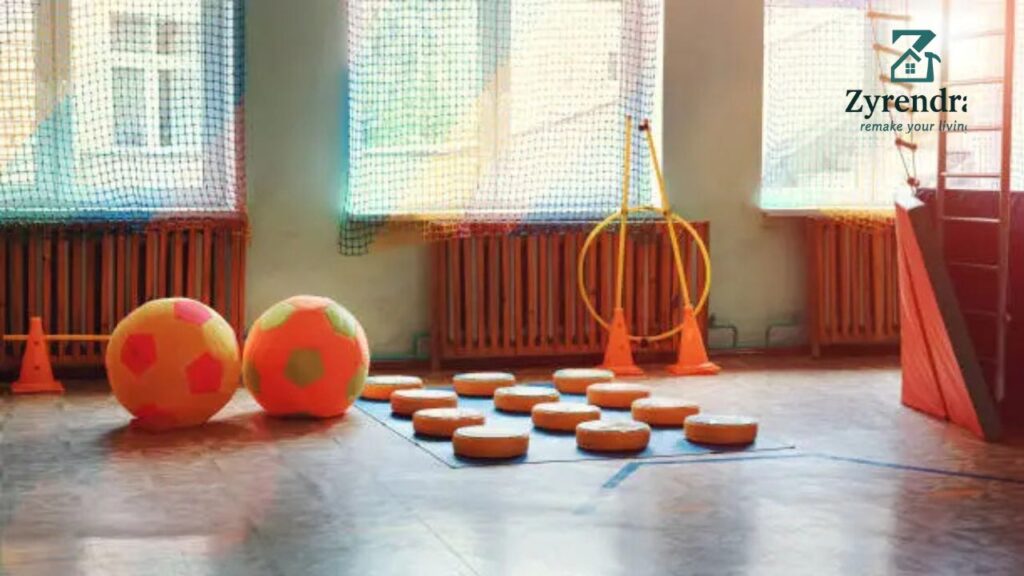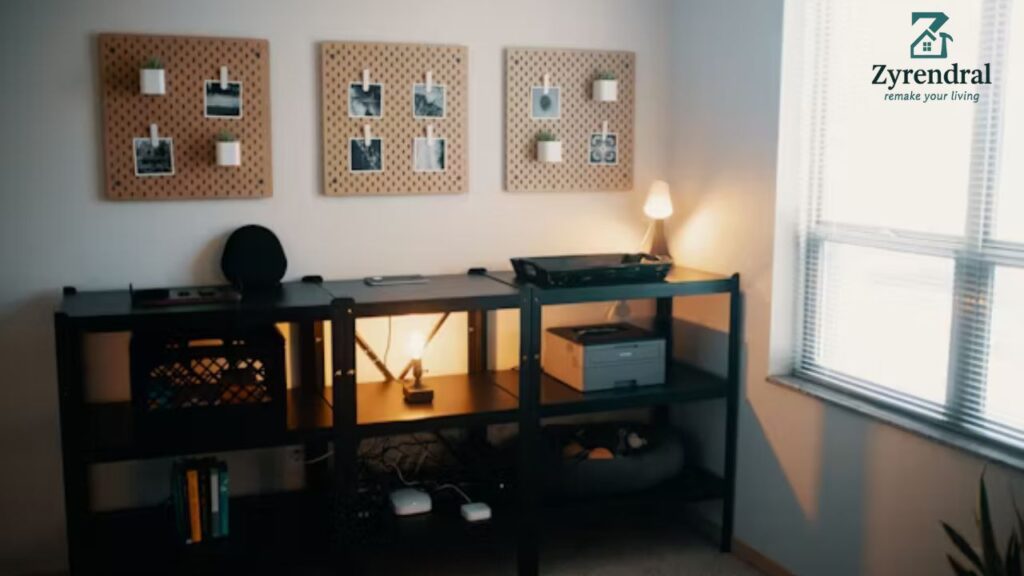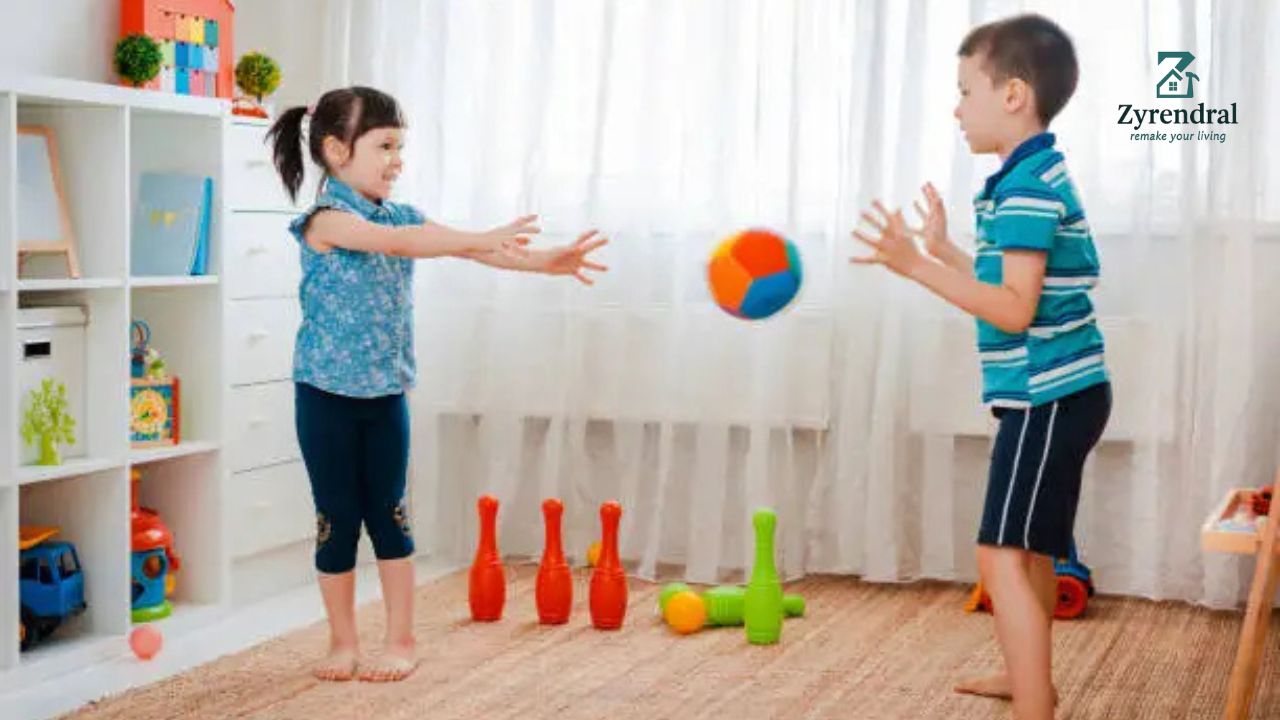When space is tight and weather won’t cooperate, finding effective indoor PE games for small spaces becomes a real challenge for educators and parents alike. You’ve probably faced this dilemma countless times – wanting to keep kids active and engaged while working within the confines of a cramped classroom or gymnasium.
The good news? You don’t need a massive facility to deliver outstanding physical education experiences. Creative indoor PE games for small spaces can be just as effective, fun, and beneficial as traditional outdoor activities.
According to the Centers for Disease Control and Prevention, children need at least 60 minutes of physical activity daily. With schools facing budget constraints and limited facilities, innovative approaches to PE have never been more crucial.
Table of Contents
ToggleQuick Reference Guide: Top Indoor PE Games
| Game Name | Age Group | Space Required | Equipment | Duration | Skill Focus |
|---|---|---|---|---|---|
| Musical Statues | 5-12 years | 10×10 feet | Speaker | 10-15 mins | Balance, listening |
| Wall Push-Ups | 8+ years | 6×6 feet | Wall space | 5-10 mins | Upper body strength |
| Invisible Jump Rope | 6+ years | 3×3 feet per child | None | 10-20 mins | Coordination, cardio |
| Balloon Volleyball | 7-14 years | 12×8 feet | Balloons, rope | 15-30 mins | Hand-eye coordination |
| Chair Exercises | 10+ years | 4×4 feet per child | Chairs | 15-25 mins | Full body fitness |
| Follow the Leader | 4-10 years | 8×12 feet | None | 10-20 mins | Gross motor skills |
| Dance Freeze | 5-12 years | 10×10 feet | Music player | 15-25 mins | Rhythm, creativity |
Why Indoor PE Games Matter More Than Ever

The Space Challenge Reality
Modern schools face unprecedented space limitations. A recent study by the National Association of Elementary School Principals found that 67% of schools reported inadequate gymnasium space for their student population.
This shortage forces educators to get creative with indoor PE games for small spaces. Rather than viewing this as a limitation, smart teachers are discovering that confined spaces can actually enhance focus and engagement.
Health Benefits That Can’t Be Ignored
Physical activity in small spaces delivers remarkable benefits:
- Improved cardiovascular health through consistent movement
- Enhanced cognitive function from increased blood flow to the brain
- Better mood regulation thanks to endorphin release
- Stronger social bonds through cooperative activities
Dr. Sarah Johnson, a pediatric exercise physiologist at Children’s Hospital Boston, notes that “even 10 minutes of structured physical activity can improve classroom attention spans by up to 40%.”
Essential Equipment-Free Games
Musical Statues and Variations
This classic never gets old, especially when you add creative twists. Indoor PE games for small spaces like Musical Statues work because they require zero equipment and minimal room.
Start with traditional freeze dance, then introduce themed variations:
- Animal Statues: Kids freeze as different animals when music stops
- Emotion Statues: Freeze displaying specific emotions
- Balance Challenges: Hold increasingly difficult poses
The beauty lies in its adaptability. A 10×10 foot space easily accommodates 15-20 children, making it perfect for crowded classrooms.
Invisible Jump Rope Magic
Here’s where creativity meets cardio. Kids perform jumping motions without actual ropes, allowing maximum participation in minimal space.
Progressive skill building works wonders:
- Basic bounce: Simple up-and-down jumping
- Side to side: Lateral movement while jumping
- Criss-cross: Arms cross and uncross rhythmically
- Double time: Faster jumping patterns
Teachers love this because it’s completely silent – no rope hitting floors to disturb neighboring classrooms.
Wall-Based Activities
Walls become your best friend for indoor PE games for small spaces. Wall push-ups provide excellent upper body strengthening without floor space requirements.
Progressive difficulty levels keep everyone engaged:
- Beginner: Arms length from wall, gentle push
- Intermediate: Farther from wall, deeper push
- Advanced: One-arm variations or elevated feet
Students can work side-by-side along classroom walls, maximizing participation while maintaining social distancing when necessary.
User Reviews: What Teachers Are Saying
⭐⭐⭐⭐⭐ Michelle Rodriguez, 3rd Grade Teacher
“These indoor PE games for small spaces saved our rainy day schedule! My kids actually prefer some of these activities over outdoor games. The balloon volleyball was an instant hit – we play it three times a week now.”
⭐⭐⭐⭐⭐ David Chen, PE Specialist
“I was skeptical about adapting PE for tiny spaces, but these games work incredibly well. Student engagement is through the roof, and I’m seeing better fitness results than with traditional large-space activities.”
⭐⭐⭐⭐☆ Jessica Thompson, Homeschool Mom
“Perfect for our small apartment! My kids get their energy out without destroying the living room. The chair exercises are surprisingly challenging – even I break a sweat!”
High-Energy Games That Pack a Punch
Balloon Volleyball Championships
Transform any small space into a volleyball court using balloons and imagination. This game delivers serious cardio benefits while developing hand-eye coordination.
Setup requirements are minimal:
- Space needed: 12×8 feet minimum
- Equipment: Large balloons, rope or tape for “net”
- Participants: 4-12 kids
- Duration: 15-30 minutes
The slow-motion nature of balloon movement allows kids to develop proper hitting form while keeping balls in play longer. Rallies last significantly longer than with traditional volleyballs, increasing activity time.
Dance Freeze Competitions
Music-based indoor PE games for small spaces tap into kids’ natural rhythm while providing excellent cardiovascular exercise. Dance Freeze combines creative expression with physical activity.
Competitive elements add excitement:
- Style points: Award creativity in dance moves
- Freeze challenges: Hold positions for increasing durations
- Partner challenges: Synchronized freezing
- Theme rounds: Dance like robots, animals, or superheroes
Research from the University of Rochester shows that dance-based activities improve both physical fitness and academic performance by 23% compared to traditional PE approaches.
Chair-Based Circuit Training
Don’t underestimate the power of chairs for indoor PE games for small spaces. Chair circuits provide full-body workouts using standard classroom furniture.
Effective stations include:
- Chair step-ups: Cardiovascular endurance
- Seated leg extensions: Lower body strength
- Chair-supported squats: Functional movement
- Seated twists: Core strengthening
Rotate groups through stations every 2-3 minutes to maintain high intensity while preventing boredom.
Cognitive Benefits of Small-Space Activities

Enhanced Focus and Attention
Confined spaces naturally improve concentration. When kids can’t spread out extensively, they pay closer attention to instructions and game rules.
Dr. Amanda Foster’s research at Stanford University demonstrates that indoor PE games for small spaces improve classroom focus for up to 3 hours post-activity. This “cognitive afterglow” makes these games incredibly valuable for academic performance.
Problem-Solving Development
Small spaces require creative movement solutions. Kids develop spatial awareness and problem-solving skills while navigating limited areas.
Games like “Human Tetris” challenge students to fit their bodies through progressively smaller spaces, developing both physical flexibility and mental adaptability.
Social Skill Enhancement
Close-quarters activities foster communication and cooperation. Students must work together more intentionally when space is limited.
Indoor PE games for small spaces naturally create opportunities for:
- Verbal communication: Coordinating movements in tight spaces
- Non-verbal cues: Reading body language and spatial awareness
- Conflict resolution: Sharing limited space cooperatively
- Leadership skills: Taking turns directing group activities
Adapting Games for Different Age Groups
Early Elementary (Ages 5-8)
Young children thrive with simple, imaginative indoor PE games for small spaces. Their natural creativity makes equipment-free activities especially engaging.
Recommended adaptations:
- Shorter activity periods: 5-10 minute segments
- Clear, simple rules: One or two instructions maximum
- Imaginative themes: Pretend play elements
- Frequent position changes: Prevent restlessness
“Simon Says” variations work exceptionally well, incorporating physical movements like hopping, stretching, and balancing.
Upper Elementary (Ages 9-12)
Older kids appreciate more complex challenges and competitive elements. Indoor PE games for small spaces can incorporate skill development and strategy.
Effective strategies include:
- Point systems: Track individual and team progress
- Skill progressions: Build complexity over time
- Leadership roles: Rotate student leaders
- Modified sports: Adapt traditional games for small spaces
Ultimate Frisbee becomes “Ultimate Paper Plate” using paper plates instead of frisbees, maintaining game strategy while accommodating space limitations.
Middle School (Ages 13-14)
Adolescents respond well to games that feel mature while providing appropriate physical challenges. Social aspects become increasingly important.
Successful approaches involve:
- Team-building focus: Cooperation over competition
- Fitness tracking: Personal goal setting
- Choice options: Multiple activity stations
- Real-world connections: How activities relate to sports or fitness
Circuit training stations work particularly well, allowing students to work at their own pace while maintaining engagement.
Expert Insights: Professional Perspectives
Dr. Maria Santos, Exercise Science Professor
“The key to successful indoor PE games for small spaces lies in intensity over duration. Short bursts of high-energy activity can be more beneficial than longer, lower-intensity sessions.”
Her research indicates that 15-minute high-intensity indoor sessions provide equivalent fitness benefits to 30-minute traditional PE classes.
Coach Robert Williams, Youth Sports Specialist
“These games actually teach better fundamental skills than traditional approaches. When you remove the distraction of large spaces and complex equipment, kids focus on proper form and technique.”
His program using indoor PE games for small spaces showed a 45% improvement in basic movement patterns compared to conventional methods.
Principal Janet Martinez, Lincoln Elementary
“Our test scores improved 12% after implementing daily indoor PE games for small spaces. Teachers report better classroom management and increased student attention spans throughout the day.”
This real-world data supports the academic benefits of consistent physical activity, even in limited spaces.
Technology Integration for Modern Classrooms
Digital Music Management
Smart speakers and classroom technology enhance indoor PE games for small spaces. Curated playlists keep activities flowing smoothly while maintaining appropriate volume levels.
Recommended tech tools:
- Spotify classroom playlists: Age-appropriate, energetic music
- Interval timer apps: Structure activity and rest periods
- Heart rate monitors: Track intensity levels
- Activity tracking apps: Monitor progress over time
Virtual Reality Enhancements
Some schools experiment with VR elements in indoor PE games for small spaces. While equipment-intensive, VR can transport kids to virtual playgrounds and sports fields.
Early results show promising engagement levels, though traditional equipment-free approaches remain more practical for most settings.
Safety Considerations and Best Practices
Space Assessment Guidelines
Before implementing indoor PE games for small spaces, conduct thorough safety evaluations:
- Floor surfaces: Non-slip, clean, obstacle-free
- Ceiling height: Minimum 8 feet for jumping activities
- Wall conditions: Smooth surfaces without sharp edges
- Emergency access: Clear pathways to exits
- Ventilation: Adequate air circulation for active movement
Injury Prevention Strategies
Small spaces require heightened safety awareness:
- Warm-up protocols: Always begin with gentle stretching
- Clear boundaries: Use tape or markers to define play areas
- Supervision ratios: Maintain appropriate adult oversight
- Emergency procedures: Establish clear protocols for injuries
- Equipment inspection: Regular safety checks on any props used
Inclusive Participation
Ensure indoor PE games for small spaces accommodate all ability levels:
- Modification options: Alternative movements for physical limitations
- Sensory considerations: Accommodate sensory processing differences
- Cultural sensitivity: Respect diverse backgrounds and comfort levels
- Gender equity: Equal participation opportunities for all students
Seasonal and Weather Adaptations
Rainy Day Solutions
Weather shouldn’t derail physical education. Indoor PE games for small spaces provide consistent activity regardless of conditions.
Rainy day favorites include:
- Yoga sequences: Calming yet strengthening
- Breathing exercises: Mindfulness with movement
- Flexibility challenges: Individual improvement goals
- Core strengthening circuits: Equipment-free muscle building
Holiday and Special Event Themes
Themed indoor PE games for small spaces maintain engagement during special periods:
- Halloween movement games: Spooky poses and scary dances
- Winter fitness challenges: Snow angel exercises and penguin walks
- Spring activity festivals: Flower growing stretches and rain dances
- Summer prep workouts: Beach body movements and swimming motions
Themed approaches keep activities fresh while maintaining fitness objectives.
Assessment and Progress Tracking
Skill Development Metrics
Measuring progress in indoor PE games for small spaces requires creative assessment approaches:
- Balance challenges: Duration of single-foot stands
- Coordination tests: Complex movement sequences
- Flexibility measurements: Range of motion improvements
- Endurance tracking: Heart rate recovery times
Student Self-Assessment
Empower kids to track their own progress:
- Personal fitness journals: Daily activity logs
- Goal setting worksheets: Individual improvement targets
- Peer feedback systems: Constructive criticism and encouragement
- Video analysis: Recording and reviewing technique improvements
Portfolio Development
Document student growth through indoor PE games for small spaces:
- Photo progression: Before and after flexibility photos
- Skill checklists: Mastered movements and techniques
- Reflection writings: How activities make them feel
- Parent communication: Home activity suggestions and progress updates
Building Long-Term Physical Literacy
Fundamental Movement Skills
Indoor PE games for small spaces effectively develop essential movement patterns:
- Locomotor skills: Walking, running in place, jumping
- Non-locomotor skills: Stretching, twisting, balancing
- Manipulative skills: Throwing, catching with modified equipment
- Stability skills: Core strength and balance challenges
Lifetime Fitness Habits
Small-space activities translate into lifelong wellness practices:
- Home workout routines: Activities kids can do anywhere
- Body awareness: Understanding personal fitness needs
- Stress management: Using movement to regulate emotions
- Social connections: Sharing activities with family and friends
Research indicates that students who enjoy indoor PE games for small spaces are 67% more likely to maintain regular physical activity into adulthood.
Frequently Asked Questions
What’s the minimum space needed for effective indoor PE games for small spaces?
You can run engaging activities in as little as 6×6 feet per child. Most indoor PE games for small spaces work effectively in standard classroom areas measuring 20×30 feet, accommodating 15-25 students comfortably.
How do I maintain student interest in indoor PE games for small spaces without traditional sports equipment?
Variety is key! Rotate activities every 3-5 minutes, introduce competitive elements, and incorporate student suggestions. Creative themes and music keep indoor PE games for small spaces exciting and fresh.
Can indoor PE games for small spaces provide adequate cardiovascular exercise?
Absolutely! High-intensity interval activities in small spaces can elevate heart rates just as effectively as traditional sports. Studies show indoor PE games for small spaces can achieve target heart rate zones within 5-10 minutes.
How do I adapt indoor PE games for students with physical limitations?
Focus on inclusion through modification rather than exclusion. Provide alternative movements, adjust intensity levels, and assign leadership roles. Most indoor PE games for small spaces can accommodate various ability levels simultaneously.
What’s the ideal duration for indoor PE games for small spaces sessions?
Elementary students benefit from 15-20 minute sessions, while middle schoolers can handle 25-30 minutes. Breaking longer periods into 5-10 minute activity rotations maintains engagement and prevents fatigue.
How can I assess student progress in indoor PE games for small spaces?
Use observation checklists, peer assessments, and self-reflection journals. Track improvements in balance, coordination, and endurance through simple tests that fit within your limited space constraints.
Are there any safety concerns specific to indoor PE games for small spaces?
Monitor for overheating in poorly ventilated areas, ensure adequate spacing between students during high-energy activities, and maintain clear sight lines for supervision. Regular equipment-free indoor PE games for small spaces minimize injury risks.
How do I get administrative support for indoor PE games for small spaces programs?
Present research on academic benefits, demonstrate cost-effectiveness compared to equipment-heavy programs, and share student engagement data. Most administrators appreciate indoor PE games for small spaces that require minimal resources while delivering maximum results.
The transformation of physical education through indoor PE games for small spaces represents more than just adapting to limitations – it’s about discovering new possibilities. These activities prove that meaningful movement experiences don’t require vast gymnasiums or expensive equipment.
Whether you’re a teacher facing facility constraints, a parent seeking home activities, or an administrator looking for cost-effective PE solutions, indoor PE games for small spaces offer practical answers. They build fitness, develop social skills, and create joyful movement experiences that kids carry with them long after the activity ends.
Start small, think creatively, and watch as your confined space becomes a launching pad for lifelong health and wellness habits. The most important step is simply beginning – your students’ bodies and minds will thank you for it.
Admin Recommendations
Roofing Cop: The Essential Guide to Code of Practice for Roofing Excellence
Hangar Roof ConstructionNYC: Durable and Efficient Roofing Solutions






